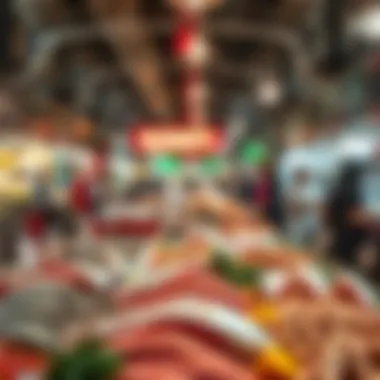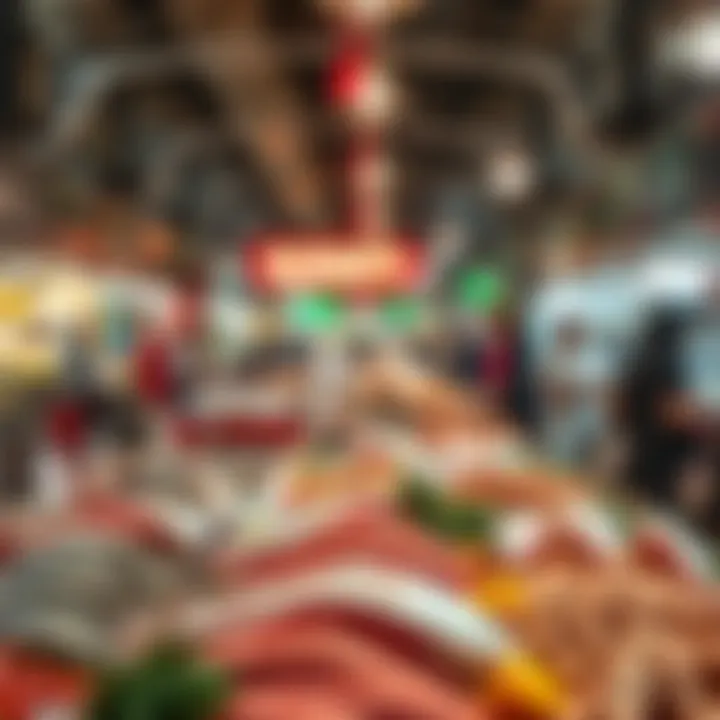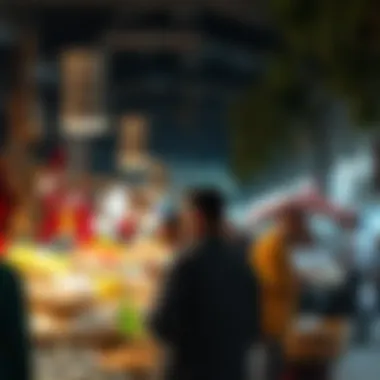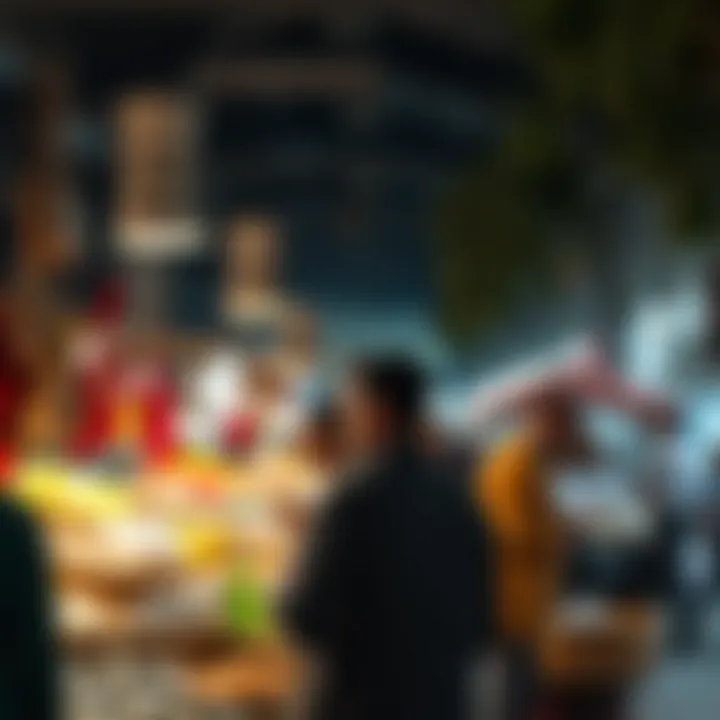Exploring Souq Al Mina: Dubai’s Fish Market Experience


Intro
Nestled in the heart of Dubai, Souq Al Mina is more than just a market; it’s a pulsating part of the city’s cultural fabric. This fish market is a vibrant hub where the past, present, and future of culinary experiences collide, making it a focal point for both locals and visitors. Here, the air is filled with the scent of saltwater and the chatter of merchants eagerly pitching their freshest catches.
What makes this place even more fascinating is the unique dance of negotiation that unfolds daily, where skills are honed in the art of bargaining over fish, crabs, and an assortment of shellfish. Beyond just the fish, the market tells a story of tradition, community and the enduring connection between the people of Dubai and the sea. In this article, we will explore the various layers that make Souq Al Mina significant, examining its history, the significance of its seafood offerings, and its role within the local economy.
As we venture deeper, our focus will weave through essential topics such as investment opportunities in residential and commercial properties surrounding the market, current trends in seafood consumption, and the ever-relevant discussion of sustainability in the fishing practices of the region. Without a doubt, understanding Souq Al Mina offers a glimpse into Dubai’s soul, where each fish sold carries stories of the deep blue and a promise of culinary delight.
Prolusion to Souq Al Mina
Souq Al Mina, known as Dubai's fish market, is much more than just a place to buy seafood. It serves as a vibrant tapestry of the city’s history, culture, and economy. Understanding Souq Al Mina provides invaluable insights into how traditional practices blend with modern influences in this bustling metropolis. For anyone interested in the intricate dance of commerce, heritage, and flavor that characterizes Dubai, this market is a microcosm worth exploring.
Location and Accessibility
Situated along the waterfront, Souq Al Mina is easily accessible for both locals and tourists. Nestled in the bustling Dubai area, it lies near major roadways and public transport lines, making it a popular stop for many. Visitors can hop on the Dubai Metro and disembark at the Al Ghubaiba station, a short taxi ride away from the market. Alternatively, the location allows for a picturesque walk along the marina, giving visitors a taste of the city's vibrant waterfront life.
Getting there isn't the only thing that matters; the market's layout encourages exploration. The narrow alleys are flanked by vendors showcasing colorful displays of seafood, with the salty aroma of the sea mingling with the lively chatter of buyers and sellers. Engaging with locals and experiencing the lively atmosphere is a key part of what makes this market special.
Historical Context
Digging into the roots of Souq Al Mina reveals layers of history that have shaped its identity over the decades. Established in the early days of Dubai’s development, the market stands as a testament to the city’s fishing heritage, which dates back to when pearl diving was the mainstay of its economy. The transformation of the fishing industry, influenced by both local and global trends, has brought significant changes to the market.
The architecture of Souq Al Mina also tells a story. With its traditional stalls and modern amenities, it embodies the blend of past and present—a physical representation of how Dubai has evolved over time. This melding of styles not only highlights the market's role as a commercial center but also reinforces its importance as a gathering place for community members, both young and old.
Understanding this historical context is crucial for investors and local businesses as it sheds light on consumer behavior and market demand. The rich history of Souq Al Mina underscores its status as more than just a fishing market; it is a cultural landmark deeply embedded in the fabric of Dubai, making it invaluable for anyone looking to engage with the city on a deeper level.
"Souq Al Mina is a living museum of Dubai’s maritime heritage, where every fish sold tells a tale of the sea and the people who depend on it."
Thus, Souq Al Mina stands as a dynamic hub of activity, encapsulating the rich tapestry of life that defines Dubai. From its accessible location to its layered history, there is much to discover in this flourishing market, drawing in visitors and fostering commerce that ties back to centuries of tradition.
Cultural Significance of the Market
Souq Al Mina is not just a place to buy fish; it is a vibrant slice of Dubai’s cultural fabric. The market attracts not only locals but also tourists, serving as a microcosm of the city’s broader traditions and practices. In understanding this market, one appreciates the role it plays in preserving culinary heritage, fostering community ties, and weaving together the region's socio-economic threads.
Traditions and Practices
Within Souq Al Mina, every bustling stall tells a story. The rituals surrounding purchasing seafood are deeply embedded in the local customs. For centuries, Dubaian fishermen have brought their catch to this market, and the energetic banter among vendors is part of what makes the experience unique. Buyers often engage in lively exchanges, negotiating prices, which is more than just a transaction; it is an essential element of community interaction. Customers learn the value of the fish on display, while sellers share knowledge about freshness, preparation techniques, and even historical stories tied to specific catches.
Some families have been associated with this market for generations, passing down not just their trade but also their relationships. You might overhear an old proprietor reminiscing about how the tides have changed, reflecting the sea’s capricious nature. Local events, such as fish auctions and community festivals, reinforce these traditions, allowing the market to serve as a gathering place that nurtures local identity and continuity amidst rapid urban development.
Role in Local Cuisine
The influence of Souq Al Mina on local cuisine cannot be overstated. Dubai's culinary landscape is a melting pot, and the market contributes significantly to that mix. With a supply of fresh seafood daily, local chefs and home cooks alike rely on this marketplace for quality ingredients, keeping age-old recipes alive amidst modern gastronomic trends. Traditional dishes, such as grilled hammour and spiced prawns, have their roots intertwined with the offerings of this market.
Fish from Souq Al Mina makes its way into many households, resonating with families who gather around a table to enjoy meals infused with the flavors of the sea. Restaurants in the vicinity often showcase specialties that speak to this coastal heritage, resulting in a delightful feast for the senses.
In summary, Souq Al Mina serves as a cornerstone for not only the economy but also the culture of Dubai. It cultivates a sense of pride among locals, reminds them of their ancestry, and preserves the art of seafood preparation. Markets like this are a reflection of a community's values, treasures that hold the essence of a place, making Souq Al Mina truly significant in the cultural landscape of Dubai.
Economic Impact of Souq Al Mina


The economic significance of Souq Al Mina extends far beyond its vibrant stalls and bustling activity. This fish market serves as a lifeline for many in Dubai, intertwining tradition with the modern economy. By examining its layers, one can appreciate how it not only boosts local businesses but also shapes the broader fishing industry and the overall economy.
Contribution to the Local Economy
Souq Al Mina plays a vital role in supporting the local economy, contributing directly to livelihoods and fostering economic growth. The market is a magnet for both residents and tourists, generating revenue for sellers and allied service providers alike.
- Job Creation: The market creates numerous jobs, from fishermen to retail operatives, benefiting countless families. Empirical analyses have shown that even a modest upsurge in local fish sales can lead to substantial employment opportunities.
- Support for Local Farmers: The fish market becomes a hub where local fishermen can sell their catch directly to consumers, cutting out intermediaries. This not only provides better prices for fishermen but also reinforces the practice of sourcing fresh, local produce.
- Cultural Exchange: Besides economic benefits, it's a place where various nationalities meet, including tourists seeking to experience the authentic flavor of Dubai. This cultural exchange further enriches the community and promotes local businesses.
In essence, the financial pulse of the market resonates through its daily operations, creating a multiplier effect in the economy that nourishes both local and visiting fish enthusiasts.
Effects on Fishing Industry
The presence of Souq Al Mina has profound implications for the fishing industry in Dubai. It influences not only how fish is sourced but also how sustainability practices are adopted across the sector.
- Demand for Fresh Seafood: As local economic activity centers on the sale of fresh fish, it creates a reliable demand for local fishermen. This encourages sustainable fishing practices that can replenish marine resources rather than deplete them. In regions where such markets thrive, studies suggest a correlation between fresh product accessibility and improved fisheries management.
- Innovation in Fishing Practices: The competitive atmosphere within Souq Al Mina pushes fishermen to adopt new methods aimed at improving yield while considering environmental conservation. Technological advances—such as eco-friendly nets or fish-finding sonar—are becoming commonplace, fostering a more responsible industry.
- Regulatory Changes: As a focal point of the fishing economy, the market often becomes a reference for regulatory authorities in establishing guidelines for sustainable fishing. Market stakeholders frequently engage with policymakers to address pressing issues such as overfishing and habitat conservation.
Visiting Souq Al Mina
Visiting Souq Al Mina is more than just a simple trip to a fish market; it’s a cultural experience embedded within the lively atmosphere of Dubai. This market stands as a vibrant hub where locals and tourists alike mingle. The sounds, sights, and smells create a unique tapestry of life that illustrates the city's maritime heritage. When planning a visit, you need to consider not only the logistical aspects but also the experience—allowing yourself to soak in the energy that pulses through this bustling link to Dubai’s culinary scene.
Market Atmosphere
Stepping into Souq Al Mina feels like diving into a sea of activity. The air is thick with the briny scent of freshly caught fish, complemented by the distant chatter of vendors hawking their wares. Brightly colored stalls display a dazzling array of seafood, from glistening snapper to odd-looking octopus, all vying for the attention of passersby. The market operates with a rhythm of its own, where the lively haggling between buyers and sellers echoes the age-old practices of trade.
Here, conversations blur with the sounds of seagulls, and the pulse of the market quickens as dawn breaks, illuminating an everyday spectacle transforming into a vibrant dance of commerce. As you navigate through the narrow pathways, it’s common to catch locals exchanging banter, sharing recipes or simply enjoying the camaraderie that this setting fosters.
In many ways, this market serves as a heartbeat for the community, nurturing ties among fishermen, chefs, and families. It becomes evident that Souq Al Mina is not merely a place to procure seafood; it's a cultural tapestry of Dubai that showcases tradition and modern life intertwined.
Tips for First-Time Visitors
If you’re planning your inaugural visit to Souq Al Mina, a little preparation can go a long way. Here are some handy tips to enhance your experience:
- Timing is Key: Arriving early will allow you to witness the market at its freshest. Vendors are typically stocked with the best catch of the day, and the atmosphere is more intimate before the crowds swell.
- Cash is King: While some stalls may accept cards, many vendors prefer cash transactions. Having dirhams on hand will make negotiations smoother.
- Be Open to Negotiation: Haggling is a customary practice in the market. Don’t be shy about discussing prices; it’s expected and often enjoyed. Start lower than what you are willing to pay, and go from there.
- Don’t Hesitate to Ask Questions: Vendors are typically knowledgeable and eager to share details about their products. Whether asking about the best cooking methods or the origin of the fish, engaging with them enriches your visit.
- Explore Beyond Seafood: While the focus naturally leans toward fish and shellfish, around the market, you’ll also find spices, herbs, and local specialties that are worth sampling.
- Plan for a Meal: After browsing, consider indulging at nearby eateries where you can sample freshly prepared dishes made from the market's catch. This offers a delicious way to round off your visit.
By being prepared and open to exploration, your visit to Souq Al Mina can transform from just another stop on your itinerary to a memorable immersion into the heart of Dubai’s seafood culture.
"To experience Souq Al Mina is to engage all your senses — it’s truly a feast for the eyes, ears, and palate."
Types of Seafood Offered
Understanding the types of seafood offered at Souq Al Mina is vital not just for potential visitors, but also for investors and local managers interested in the seafood trade. This bustling market serves as a mirror reflecting not just economic trends but also cultural preferences and culinary traditions ingrained within the community. From the stands brimming with fish to vendors moving around with crates of shells, the variety is immense and speaks to the region’s rich marine resources.
Varieties of Fish
At Souq Al Mina, the fish selection is nothing short of impressive. Visitors can find everything from large, glimmering kingfish to smaller, delicate pomfrets, each with its own unique flavor profile. The local catch often includes:
- Hamour: A favorite among locals, this fish can be found grilled or served in traditional dishes such as fish curry.
- Sohal Surgeonfish: Known for its striking colors, this fish is often appreciated not just for its taste but also for the way it brightens a plate.
- Mackerel: This fish is frequently smoked or grilled, packed full of flavor and rich in omega-3 fatty acids, making it a staple for health-conscious diners.
These varieties aren’t merely food options; they symbolize the vibrant culture of seafood consumption in Dubai. The significance goes beyond catering to tastes; the diversity also supports local fishermen and their livelihoods. Understanding the types of fish available can help buyers make informed decisions about their purchases while promoting sustainability in the local fishing industry.
Shellfish and Other Options


When it comes to shellfish, Souq Al Mina does not disappoint. The market offers a plethora of shellfish options, showcasing the bounty of the Arabian Gulf. Some popular choices include:
- Shrimp: Available in various sizes, they are highly sought after for their versatility. They can be used fresh in salads or marinated for grilling.
- Crabs: Freshly caught crabs are a local delicacy, often enjoyed in traditional dishes or simply steamed to let their flavor shine.
- Clams and Mussels: These shellfish add a unique touch to many dishes, especially seafood platters, and are favored for their tender meat.
This abundance of shellfish not only caters to diverse tastes but accentuates the market's role in the culinary landscape of Dubai. The availability of such fresh, local seafood can shift the balance for restaurant owners and home chefs alike, allowing them to create authentic experiences with each ingredient they choose to highlight in their dishes.
"Seafood isn't just a meal; it's a conversation starter and a cultural touchstone, especially in a market like Souq Al Mina."
Negotiation Practices
Negotiation practices at Souq Al Mina are more than a mere back-and-forth exchange over fish prices; they encapsulate a cultural tradition that speaks volumes about the community's values and interactions. For anyone looking to engage in transactions at this vibrant marketplace, understanding the nuances of bargaining is paramount. This knowledge not only aids in securing the best deals but also fosters a sense of respect and appreciation for the traders and their craft.
Understanding Bargaining Culture
The art of negotiation here is steeped in history and local customs. Fishermen and vendors at Souq Al Mina often see the bargaining process as an essential aspect of the transaction. It's not just about money; it’s a social interaction that builds relationships. This can be likened to a dance—one person makes an offer, the other counters, and through this back-and-forth, a mutual understanding is formed.
Visitors can expect to hear lively exchanges as fishmongers proudly tout their catches of the day, while potential buyers haggle, hoping to get the best deal for their fresh seafood. To them, it’s not just transactional; it’s personal. Imagine walking into a marketplace where your bargaining efforts not only affect the price but also build a rapport with the seller, which can lead to better deals in future visits.
Adopting an amiable demeanor is essential. A smile goes a long way. When you express genuine interest in the fish and ask the seller about their day, you are not merely negotiating a price; you are participating in a cultural ritual that honors the community's traditions. According to locals, "It’s not always about the lowest price. Sometimes it’s about the connection you create."
Strategies for Successful Negotiation
If you’re gearing up for a trip to Souq Al Mina to snag some fresh seafood, consider these strategies to navigate the negotiation waters:
- Do Your Homework: Familiarize yourself with the types of fish available and their market prices. Knowing the baseline helps in establishing realistic expectations and a fair price.
- Show Respect: Approach the seller with respect and politeness. A warm greeting can help ease tensions and open conversations.
- Be Patient: Give yourself enough time. Haggling might seem tedious, but it’s part of the experience. Rushing might close more doors than you realize.
- Use Humor: When appropriate, a light-hearted comment can break the ice and make negotiations feel less like a tense battle.
- Walk Away If Necessary: If you sense the price is too high, don’t hesitate to walk away. Often, sellers may call you back with a better offer, seeing your serious intent to negotiate.
Ultimately, successful negotiation at Souq Al Mina is as much about the ability to interact socially as it is about striking a good deal. The charm lies in the process, not just the purchase.
"Negotiating at Souq Al Mina is about finding balance—between respect for the seller and the desire to get a good price. It’s where commerce meets community."
By engaging meaningfully in this bargaining culture, visitors stand to gain not just great seafood but a deeper understanding of the local lifestyle and an enriched market experience.
Sustainability and Environmental Concerns
The dialogue surrounding sustainability and environmental concerns has taken center stage in modern markets, and Souq Al Mina is no exception. The importance of sustainable practices cannot be overstated, especially given the ecological ramifications of overfishing and pollution in marine environments. Increased consumer awareness has prompted a shift in how seafood is sourced, highlighting the need for sustainable fishing to maintain marine biodiversity and support the livelihoods of communities dependent on these resources.
Current Challenges
Despite advances in awareness and technology, Souq Al Mina faces significant challenges in promoting sustainability.
- Overfishing: There’s a pressing concern regarding the sustainability of various fish stocks. Many local varieties are fished at rates that exceed their natural replacement capacity, threatening their long-term viability.
- Pollution: The coastal waters around Dubai are subject to industrial runoff, which tarnishes the surrounding marine ecosystem. This pollution can harm not only the fish but also the quality of seafood supplied at the market, which may deter conscientious consumers.
- Climate Change: Rising sea temperatures and acidification are affecting fish species and their habitats. The changing climate can lead to unpredictable fish migrations, impacting local supplies and traditional fishing methods.
In light of these challenges, it becomes crucial for stakeholders to identify a path that balances economic interests with environmental safeguards.
Efforts in Sustainable Fishing
Various initiatives are underway to combat these problems and foster a more sustainable seafood industry at Souq Al Mina.
- Traceability Programs: A growing number of vendors are adopting traceability measures, allowing customers to know exactly where their seafood comes from. This transparency encourages ethical sourcing and helps consumers make informed choices.
- Community Initiatives: Local fishermen and vendors are joining hands with environmental organizations to promote responsible fishing techniques that minimize ecological impact. Educational workshops on sustainable practices have been implemented, fostering a culture of stewardship among participants.
- Legislation Changes: The Dubai government is increasingly focused on implementing regulations that promote sustainable fishing. Restrictions on certain fishing methods and seasonal closures to allow populations to recover are steps being taken to preserve marine life.
- Aquaculture Projects: There’s a rising interest in aquaculture as an alternative to wild-caught fish. These programs aim to produce seafood through controlled breeding, significantly reducing pressure on wild fish populations while maintaining supply for the market.


The ongoing efforts to combine tradition with sustainability at Souq Al Mina could set benchmarks for other markets to follow, ultimately contributing to a more environmentally responsible seafood trade.
As challenges persist, it is clear that collective action—combined with innovative solutions—will be essential for preserving Souq Al Mina as a cornerstone for the community while safeguarding marine resources for generations to come.
Comparative Analysis with Other Markets
Comparative analysis with other markets is crucial for understanding the position and significance of Souq Al Mina within a global context. By comparing Souq Al Mina to both regional and global fish markets, we can appreciate its unique characteristics, operational dynamics, and broader economic implications.
Regional Fish Markets
When examining regional fish markets, it's vital to consider how local traditions and preferences shape the success and viability of these markets. For example, the fish markets in Oman and Bahrain share a few similarities with Souq Al Mina, particularly their emphasis on fresh local catch.
- Oman's Muttrah Fish Market is a hub for fresh seafood, much like Souq Al Mina, showcasing an array of local fish, but often with less emphasis on the negotiation culture common in Dubai.
- In Bahrain, the Manama Fish Market features a vibrant mix of seafood but leans heavily on imported products, which can impact pricing and freshness compared to the seafood directly sourced from nearby waters that Souq Al Mina offers.
Comparing these markets reveals that Souq Al Mina not only stands out due to its negotiating practices but also due to its concentrated effort to promote local fishing, an effort that is less pronounced in some other regional counterparts.
Global Perspectives
On a global stage, the dynamics shift considerably. For instance, markets like Tsukiji in Tokyo or the historic Mercado de la Ribera in Bilbao offer consumers unparalleled variety and quality but operate within different cultural contexts.
Points of comparison include:
- Variety of Seafood: Souq Al Mina provides a selection that echoes the Mediterranean influence, with a focus on types like hammour and shrimp, while markets in Japan showcase species uncommon in the Gulf region, such as fugu (pufferfish) and various types of shellfish.
- Cultural Practices: The haggling at Souq Al Mina reflects a communal aspect of trading that’s less common in Europe and North America where many markets hinge on fixed prices. In contrast, the ambiance at Tsukiji is almost ritualistic, with a focus on precision and quality, rather than negotiation.
- Environmental Concerns: Globally, many markets, including those in the U.S., face significant scrutiny regarding sustainability and fishing practices. Souq Al Mina, grappling with similar challenges, has begun to adopt sustainable fishing practices, a movement that is becoming increasingly necessary for fish markets worldwide.
Unlike many Western fish markets, which may lean towards standardization and efficiency, the Souq Al Mina embodies the raw authenticity of market trading, complete with the unique cultural flair of Dubai. This cultural and environmental awareness is critical for investors looking to navigate the market effectively.
In essence, while Souq Al Mina mirrors many regional traits, its distinct interplay between tradition and modernity positions it uniquely among global markets, making it a focal point for those interested in the seafood trade.
Understanding these comparisons not only informs potential investors about market trends but also highlights the vibrancy and richness of local culture encapsulated in Souq Al Mina. By integrating insights from comparable markets, stakeholders can develop strategies that are attuned to both local and broader economic environments.
For those interested in fish markets, observing how these differences manifest can provide valuable insights into market behavior and consumer preferences, guiding investment and operational strategies effectively.
Future Prospects of Souq Al Mina
As Dubai continues to evolve into a global hub for trade and tourism, the future of Souq Al Mina presents exciting opportunities that reflect both local and international trends in seafood consumption. Not only does this bustling marketplace cater to the demands of residents, but it also aims to attract a growing number of tourists eager to experience authentic local culture through its vast array of seafood offerings. Understanding these future prospects provides key insights for potential investors and stakeholders aiming to tap into the region's fish market.
Trends in Seafood Consumption
The trends shaping seafood consumption are diverse and dynamic.
- Health Consciousness: As more people begin prioritizing health, they are increasingly opting for seafood due to its reputation as a healthier protein source. Fish such as salmon and mackerel, rich in omega-3 fatty acids, are becoming staples in many diets.
- Sustainability Awareness: There’s a noticeable shift towards sustainable and ethically sourced seafood. Consumers are scrutinizing where their food comes from, favoring markets, like Souq Al Mina, that promote transparent sourcing and environmental responsibility.
- Exotic Flavors and Varieties: The influx of international tourists is sparking interest in diverse seafood selections, from more traditional local fish like hamour to exotic offerings like seabream or even less common shellfish. This demand can lead to enticing new menus at local restaurants and a unique culinary experience at the market itself.
In light of these trends, Souq Al Mina can position itself as a leader not just in local seafood supply but as a beacon of sustainability and health-focused consumption in the region.
Potential for Development and Expansion
The economic potential for Souq Al Mina is vast and merits careful consideration.
- Infrastructure Improvements: As Dubai invests in improving its infrastructure, Souq Al Mina stands to benefit from enhanced accessibility and amenities. Upgraded facilities could boost the market's appeal to both residents and tourists, leading to increased foot traffic.
- Technological Integration: Modernizing the market through technology could streamline operations. Initiatives could include digital platforms that facilitate order placements or mobile applications that allow customers to track the freshness of their seafood choices. Each innovation could elevate the shopping experience and attract tech-savvy consumers.
- Expansion of Product Range: Adding more products that align with global culinary trends could further attract a diverse clientele. This could mean introducing gourmet seafood items or organic variants that appeal to health-centric buyers.
As the marketplace navigates through these developments, the insights and data gleaned from consumer behavior could serve to inform strategic decisions, tailoring the offerings to meet evolving preferences effectively.
"The future of Souq Al Mina could very well shape the seafood landscape in Dubai, turning it into a pivotal player not only in local but also in the global seafood market."
For more information on sustainable seafood and market practices, take a look at these resources:
World Wildlife Fund - SeafoodWatch - Food and Agriculture Organization
Through careful planning and responsiveness to consumer trends, Souq Al Mina is not just a market; it’s fostering a culture that appreciates the importance of responsible seafood practices, poised for a flourishing future.







